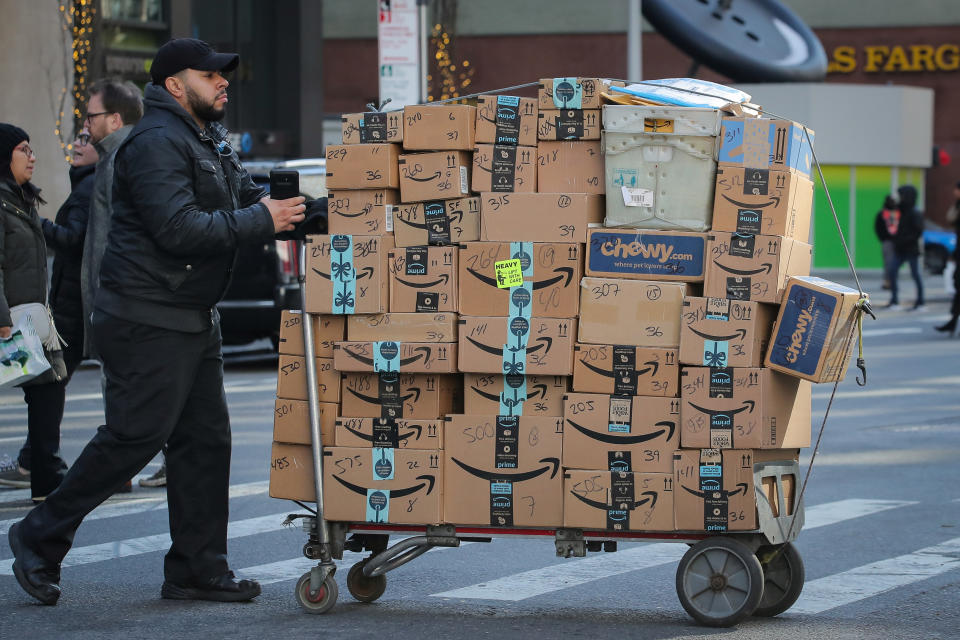Here's how much Amazon sold on Prime Day this year, according to analysts
Amazon’s (AMZN) 2019 Prime Day was its biggest sales event yet, the company reported Wednesday. And analysts agree, with at least two experts estimating that more than $6 billion worth of goods were sold on Amazon’s platform.
Amazon on Wednesday touted this year’s event as “the largest shopping event in Amazon history,” with Amazon Prime members in more than 18 countries saving more than $1 billion in products purchased over the course of Prime Day. The fifth annual sales extravaganza expanded to 48 hours this year, adding an extra 12 hours from last year.
The company said it sold more than 175 million items over the course of the event, up from 100 million items last year. Amazon-branded electronics including the Echo Dot, Fire Stick, and other Alexa-enabled devices were among the top-sellers, Amazon reported. Meanwhile, third-party sales volume topped $2 billion during this year’s Prime Day, up from $1.5 billion last year.
Amazon does not disclose official gross merchandise volume (GMV) — or dollar amount of merchandise sold online — attributable to Prime Day. However, based on the metrics provided, outside research firms and Wall Street analysts compiled their own estimates for the company’s Prime Day GMV.
As of the close of Prime Day, most research firms estimated that Amazon had topped earlier sales expectations for the event, as clicker-happy customers perused discounts on everything from big-screen TVs to mattresses to pressure cookers.
Amazon saw at least $6.2 billion in GMV during Prime Day 2019, according to market intelligence firm IgnitionOne. That topped the firm’s pre-Prime Day estimate for $6.1 billion in GMV, and was about $2 billion higher than sales garnered during last year’s event.
Wall Street analysts’ estimates fell in a similar range. Baird analyst Colin Sebastian wrote in a note Wednesday that he estimated close to $6 billion in Prime Day volume, representing an increase of at least 25% over last year’s event when normalized by unit sales per hour.
Prior to the end of Prime Day, many major research firms — including Coresight Research, Internet Retailer, JPMorgan, and Bank of America Merrill Lynch — had initially expected Amazon to post GMV north of $5 billion over the course of the event.
‘Biggest shopping event in Amazon’s history’
Even before final sales estimates began rolling in, Prime Day 2019 was expected to be “the biggest shopping event in Amazon’s history, surpassing Black Friday, Cyber Monday and the previous Prime Day,” CFRA analyst Camilla Yanushevsky wrote in a note last week.

Other analysts attributed additional major benefits to Amazon, beyond the hard and fast sales figures.
“We believe Prime Day services three primary purposes for Amazon: (1) generating significant volume at a seasonally slow time of the year; (2) driving incremental Prime subscriptions; and (3) providing valuable free advertising,” Loop Capital Markets analyst Anthony Chukumba wrote in a note Monday, prior to the end of Prime Day. “We think Prime Day will also provide an opportunity to highlight Amazon’s recent introduction of free one-day delivery for Prime members.”
The event has provided an opportunity for Amazon to bring new members onto its $119 per year Prime subscription, helping create a vital recurring revenue stream for the company and helping offset costs associated with the event.
Amazon said in a statement that it “welcomed more new Prime members on July 15 than on any previous day, and almost as many on July 16 – making these the two biggest days ever for member signups.”
“Overall, we believe Amazon’s Prime Day(s) shopping event achieved key goals of promoting the Prime membership program with fast delivery, as well as increasing penetration of Alexa-enabled voice and other smart home devices,” Baird’s Sebastian wrote in a note Wednesday.
“Consistent with other shopping holidays (e.g. Black Friday, Cyber Monday, Singles Day in China), Prime Day generated a significant amount of free advertising for Amazon, which notably was leveraged by other e-tailers, including eBay and Walmart for their own promotions,” he added.
‘Halo effect’
The Prime Day benefits didn’t ended with Amazon, according to Adobe Analytics.
Ahead of Amazon’s holiday, Adobe analysts anticipated that other online retailers would see “an increasingly strong ‘Halo effect’ on Prime Day” as they stepped up sales around Amazon’s holiday to compete. Firms including Walmart (WMT), eBay (EBAY), and Target (TGT) each rolled out sales of their own to coincide with Prime Day this year.
Based on data over the course of the two-day event, those efforts paid off.
“The first day of Prime Day saw a substantial increase in online spending in the U.S., suggesting that Amazon is no longer the sole winner of the summer shopping holiday,” Adobe analysts wrote in a report Tuesday.
Large retailers with more than $1 billion in annual revenue saw a 64% increase in sales versus an average Monday, the analysts said, stronger than the 54% increase other large retailers saw on the first day of Prime Day last year. On the second day, large retailers saw a 72% increase in sales compared to an average Tuesday.
Meanwhile, niche retailers with less than $5 million in annual revenue saw a 30% increase in online sales on Monday, and a 25% increase on Tuesday.
“We’ve definitely seen in discount retail, a significant increase in sales because of Prime Day, because of them leveraging something Amazon essentially built, to their benefit,” IgnitionOne COO Chris Hansen told Yahoo Finance.
This post has been updated with new estimates and revisions for Amazon’s Prime Day results. This post was originally published on July 15, 2019.
Emily McCormick is a reporter at Yahoo Finance. Follow her on Twitter.
Read more Prime Day coverage: